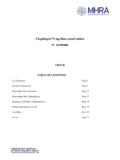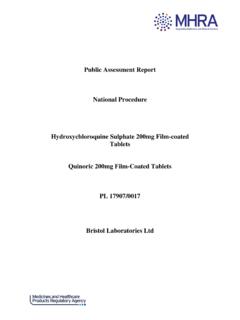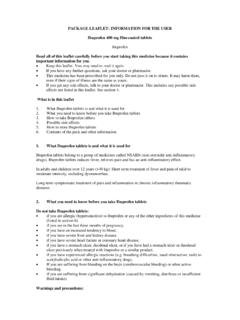Transcription of NEW ZEALAND DATA SHEET 1. MAXIGESIC TABLET
1 NEW ZEALAND DATA SHEET 1. MAXIGESIC TABLET MAXIGESIC TABLET Paracetamol 500 mg/Ibubrofen 150 mg. 2. QUALITATIVE AND QUANTITATIVE COMPOSITION MAXIGESIC : Each TABLET contains 500 mg of paracetamol and 150 mg of ibuprofen. Excipients with known effect: Maize starch, microcrystalline cellulose, crosscarmellose sodium, magnesium stearate, opadry white and talc. For the full list of excipients, see section 3. PHARMACEUTICAL FORM TABLET . A white coloured, capsule shaped, film coated TABLET with breakline on one side and plain on the other side. 4. CLINICAL PARTICULARS Therapeutic indications MAXIGESIC tablets are indicated for relief of pain and reduction of fever and inflammation. Dose and method of administration Adults and Children over 12 years: The usual dosage is 1-2 tablets taken every four to six hours, up to a maximum of eight tablets in 24 hours.
2 Children under 12 years: MAXIGESIC is not recommended for children under 12 years. Contraindications MAXIGESIC is contraindicated for use in patients with known hypersensitivity reaction to paracetamol, ibuprofen, other NSAIDs or any other ingredients in the product. MAXIGESIC is contraindicated for use in patients with severe heart and renal failure (glomerular filtration below 30ml/min). MAXIGESIC is contraindicated for use in women during third trimester of pregnancy. Paracetamol Paracetamol should not be used in patients with active alcoholism as chronic excessive alcohol ingestion may predispose patients to paracetamol hepatoxicity. Ibuprofen Ibuprofen should not be given to patients who have experienced asthma, urticaria, or allergic-type reactions after taking aspirin or other NSAIDs. Severe, rarely fatal, anaphylactic-like reactions to NSAIDs have been reported in such patients (see Precautions, Pre-existing Asthma).
3 Ibuprofen is contraindicated for use in patients with active gastrointestinal bleeding or peptic ulceration. Use of ibuprofen is contraindicated during the third trimester of pregnancy (see Use in pregnancy). MAXIGESIC should not be taken with other products containing ibuprofen, aspirin, salicylates or with any other anti-inflammatory medicines unless under a doctor s instruction. Refer to Interactions with other medicines for additional information. Special warnings and precautions Use in Chronic Liver Disease or a History of Liver Disease Paracetamol: Paracetamol at higher than recommended doses can lead to hepatotoxicity and even hepatic failure and death. Paracetamol can be used in patients with liver disease and has been studied in both one-time single (1500 mg) and multiple doses (4000 mg/d) in adult patients with chronic stable liver disease. A double-blind, two-period, crossover study was conducted to evaluate the use of 4000 mg/d of paracetamol for 13 days in patients with stable chronic liver disease.
4 There were no abnormalities indicative of an adverse reaction to paracetamol. The metabolism following a single 1500-mg dose was compared in normal subjects, patients with mild liver disease, and patients with severe liver disease. There were no significant differences in overall 24-hour urinary excretion of paracetamol and glucuronide, cysteine, and mercapturic acid conjugates of paracetamol. Following a single (10 mg/kg) dose of paracetamol, the pharmacokinetic profiles in patients with mild, moderate, or severe liver disease were not significantly different. Although the plasma half-life of paracetamol was prolonged in patients with severe liver disease, there were no significant differences in the 24-hour (adult) and 36-hour (children) urinary excretion of paracetamol or its conjugates (glucuronide, cysteine, mercapturic acid). Ibuprofen: Patients with impaired liver function or a history of liver disease who are on long term ibuprofen therapy should have hepatic function monitored at regular intervals.
5 Ibuprofen has been reported to have a minor and transient effect on liver enzymes. Severe hepatic reactions, including jaundice and cases of fatal hepatitis, though rare, have been reported with ibuprofen as with other NSAIDs . If abnormal liver tests persist or worsen, or if clinical signs and symptoms consistent with liver disease develop, or if systemic manifestations occur ( eosinophilia, rash, etc.), ibuprofen should be discontinued Use in Renal Disease Paracetamol: Paracetamol can be used in patients with chronic renal disease without dosage adjustment. In a single-dose study, the disposition and metabolite kinetics of 1000 mg of paracetamol were compared in patients with renal disease and in healthy volunteers. The fractional urinary recovery of paracetamol and its conjugates ( , glucuronide, sulphate, cysteine, mercapturate) was similar in healthy volunteers and in patients with moderate renal failure.
6 In a 10-day, multi-dose study, the disposition of paracetamol 3000 mg daily in healthy volunteers was compared with patients with chronic renal failure. A slight increase in predose trough paracetamol levels was noted in patients with renal failure ( g/mL) compared with controls ( g/mL), but there was no evidence of accumulation of the glutathione-derived metabolites of paracetamol ( , cysteine, mercapturate). Although mean daily predose plasma concentrations of sulphate and glucuronide conjugates were higher in patients with chronic renal disease, these conjugates disappeared rapidly when paracetamol was discontinued. There is no significant risk of paracetamol toxicity in patients with moderate to severe renal failure. Ibuprofen: Caution should be used when initiating treatment with ibuprofen in patients with considerable dehydration. The two major metabolites of ibuprofen are excreted mainly in the urine and impairment of renal function may result in their accumulation.
7 The significance of this is unknown. NSAIDs have been reported to cause nephrotoxicity in various forms; interstitial nephritis, nephritic syndrome and renal failure. In patients with renal, cardiac or hepatic impairment, those taking diuretics and ACE Inhibitors, and the elderly, caution is required since the use of nonsteroidal anti-inflammatory drugs may result in deterioration of renal function. The dose should be kept as low as possible and renal function should be monitored in these patients. Use in Older Patients Paracetamol: No adjustment in labelled dosage is necessary for older patients who require paracetamol therapy. Those who require therapy for longer than 10 days should consult their physician for condition monitoring; however, no reduction in recommended doge is necessary. Ibuprofen: Ibuprofen should not be taken by adults over the age of 65 without consideration of comorbidities and co-medications because of an increased risk of adverse effects, in particular heart failure, gastrointestinal ulceration and renal impairment.
8 Haematological Effects Paracetamol: Glucose-6-Phosphate Dehydrogenase (G6PD) Deficiency In therapeutic doses, paracetamol does not shorten the lifespan of red blood cells and does not produce any clinically perceptible destruction of circulating red blood cells. It can alter the metabolism of oral anticoagulants (see Interactions with Other Medicines). Ibuprofen: Haematological Monitoring Blood dyscrasias have been rarely reported. Patients on long-term therapy with ibuprofen should have regular haematological monitoring. Coagulation Defects Like other NSAIDs, ibuprofen can inhibit platelet aggregation. Ibuprofen has been shown to prolong bleeding time (but within the normal range), in normal subjects. Because this prolonged bleeding effect may be exaggerated in patients with underlying haemostatic defects, ibuprofen should be used with caution in persons with intrinsic coagulation defects and those on anti-coagulation therapy.
9 Gastrointestinal Events Ibuprofen: Upper GI ulcers, gross bleeding or perforation have been described with NSAIDs. The risks increase with dose and duration of treatment and are more common in patients over the age of 65 years. Some patients will experience dyspepsia, heartburn, nausea, stomach pain or diarrhoea. These risks are minimal when MAXIGESIC is used at the prescribed dose for a few days. Ibuprofen should be used with extreme caution, and at the lowest effective dose for the shortest duration, in patients with a history of gastrointestinal haemorrhage or ulcer since their condition may be exacerbated. MAXIGESIC should be discontinued if there is any evidence of gastrointestinal bleeding. The concurrent use of aspirin and NSAIDs also increases the risk of serious gastrointestinal adverse events. Cardiovascular Thrombotic Events Ibuprofen: Epidemiological data suggest that use of ibuprofen, particularly at a high dose (2400 mg/daily) and in long term treatment, may be associated with a small increased risk of arterial thrombotic events such as myocardial infarction or stroke.
10 Overall, epidemiological studies do not suggest that low dose ibuprofen ( 1200mg/ daily) is associated with an increased risk of arterial thrombotic events. Patients with uncontrolled hypertension, congestive heart failure, established ischaemic heart disease, peripheral arterial disease, and/or cerebrovascular disease should only be treated with ibuprofen after careful consideration. Similar consideration should be made before initiating longer-term treatment of patients with risk factors for cardiovascular events ( hypertension, hyperlipidaemia, diabetes mellitus, smoking). There is no consistent evidence that the concurrent use of aspirin mitigates the possible increased risk of serious cardiovascular thrombotic events associated with NSAIDs use. Hypertension: NSAIDs may lead to onset of new hypertension or worsening of pre-existing hypertension and patients taking antihypertensive medicines with NSAIDs may have an impaired anti-hypertensive response.














